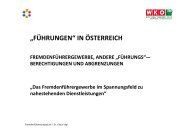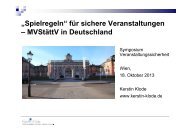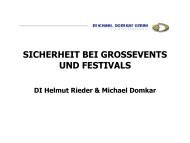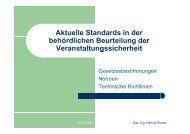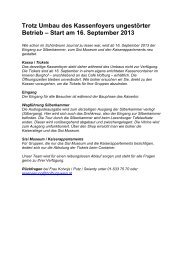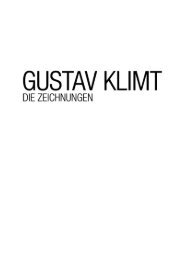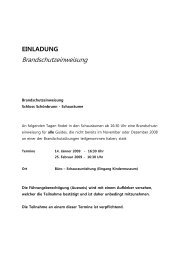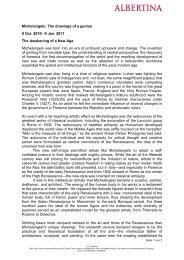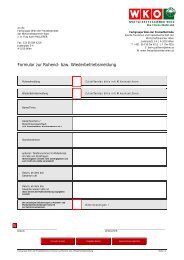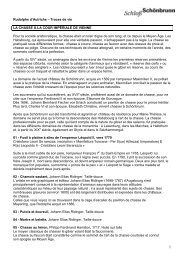kunstkammer vienna the cradle of the museum - Freizeitbetriebe ...
kunstkammer vienna the cradle of the museum - Freizeitbetriebe ...
kunstkammer vienna the cradle of the museum - Freizeitbetriebe ...
You also want an ePaper? Increase the reach of your titles
YUMPU automatically turns print PDFs into web optimized ePapers that Google loves.
INTRODUCTION<br />
PROJECT DEFINITION<br />
INSTALLATION CONCEPT<br />
The Kunstkammer Vienna evolved from <strong>the</strong> treasuries and Kunstkammer<br />
collections assembled by <strong>the</strong> Habsburgs in <strong>the</strong> late Middle Ages, <strong>the</strong> Renaissance<br />
and <strong>the</strong> Baroque. Over <strong>the</strong> centuries, individual collectors from <strong>the</strong> House <strong>of</strong><br />
Habsburg augmented <strong>the</strong>se holdings. The foremost among <strong>the</strong> latter are <strong>the</strong><br />
Kunstkammer assembled at Ambras Castle by Archduke Ferdinand II († 1595), and<br />
that <strong>of</strong> Emperor Rudolf II († 1612) at Prague, <strong>the</strong> Kunstkammer <strong>of</strong> Archduke<br />
Leopold Wilhelm († 1662) in Brussels and Vienna, and <strong>the</strong> Imperial Treasury in<br />
Vienna. It was, however, Emperor Franz Josef who reorganised <strong>the</strong> imperial<br />
collections by amalgamating <strong>the</strong> various holdings and displaying <strong>the</strong>m toge<strong>the</strong>r for<br />
<strong>the</strong> first time in <strong>the</strong> newly-erected Kunsthistorisches Museum, which was opened to<br />
<strong>the</strong> public in 1891. Initially called „Sammlung kunstindustrieller Gegenstände“<br />
(Arts and Crafts Collection), it was renamed „Sammlungen für Plastik und<br />
Kunstgewerbe” (Collection <strong>of</strong> Sculpture and Decorative Arts) in 1919; since 1991 it<br />
is called “Kunstkammer”; <strong>the</strong> historical term is a reflection <strong>of</strong> <strong>the</strong> fact that almost<br />
all <strong>of</strong> <strong>the</strong> holdings <strong>of</strong> goldsmith work and carved stones, <strong>of</strong> bronze statuettes and<br />
ivories assembled here were never intended for practical use but solely for display<br />
in a princely Kunstkammer, with large sculptures and practical objects made by<br />
craftsmen playing but a minor role.<br />
A Kunstkammer was regarded as a reflection <strong>of</strong> <strong>the</strong> cosmos and <strong>of</strong> <strong>the</strong> world that<br />
could be experienced in <strong>the</strong> microcosm <strong>of</strong> its holdings, as well as a depository <strong>of</strong><br />
contemporary knowledge, its aim to elicit surprise and amazement. In addition to<br />
artefacts in <strong>the</strong> narrow sense <strong>of</strong> <strong>the</strong> word, Kunstkammer collections also included<br />
Naturalia (curious manifestations <strong>of</strong> flora, fauna or minerals), objects produced by<br />
strange civilisations or in distant lands (Exotica), scientific instruments for studying<br />
<strong>the</strong> cosmos or charting <strong>the</strong> world (Scientifica), books, and artworks from classical<br />
antiquity.<br />
However, only a fraction <strong>of</strong> this former wealth <strong>of</strong> objects has remained in today’s<br />
Kunstkammer. Since <strong>the</strong> late nineteenth century efforts to structure and re-organise<br />
<strong>the</strong>m have greatly altered <strong>the</strong> former Habsburg collections. New <strong>museum</strong>s such as<br />
<strong>the</strong> Natural History Museum or <strong>the</strong> Museum <strong>of</strong> Ethnology were founded to house<br />
parts <strong>of</strong> <strong>the</strong> holdings that once made up <strong>the</strong> Kunstkammer collections. However, <strong>the</strong><br />
Kunstkammer Vienna <strong>of</strong> <strong>the</strong> Kunsthistorisches Museum Wien remains one <strong>of</strong> <strong>the</strong><br />
most important collections <strong>of</strong> its kind in <strong>the</strong> world. The personalities <strong>of</strong> <strong>the</strong><br />
collectors who assembled it were scions <strong>of</strong> one <strong>of</strong> Europe’s most powerful and<br />
influential ruling families, blessed with wide-ranging contacts and deep pockets.<br />
The patron’s high rank is reflected both in <strong>the</strong> outstanding quality and artistic merit<br />
<strong>of</strong> <strong>the</strong> artefacts he collected and <strong>the</strong>ir sheer numbers – which is why <strong>the</strong> holdings in<br />
<strong>the</strong> Kunstkammer Vienna are so important and spectacular.<br />
The Kunstkammer Vienna has been closed to <strong>the</strong> public since 2002. Around 2.200<br />
important artworks have been selected for <strong>the</strong> new installation, which presents <strong>the</strong>m<br />
on 2.700 m² adapted to conform to international conservation and safety standards<br />
without exceeding ei<strong>the</strong>r our budget or <strong>the</strong> schedule. Using traditional and new



